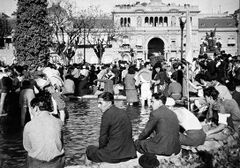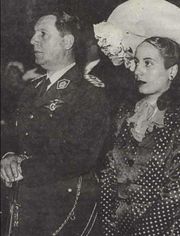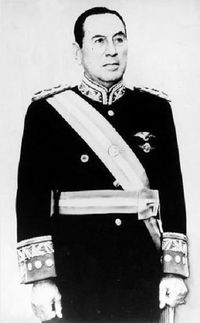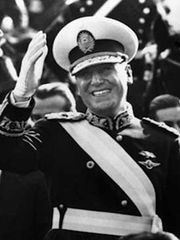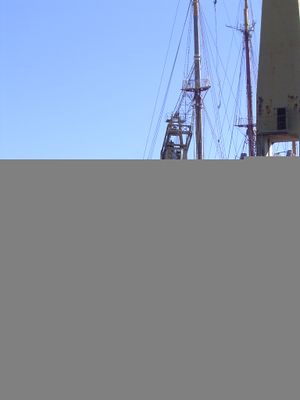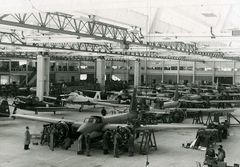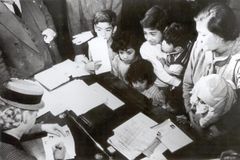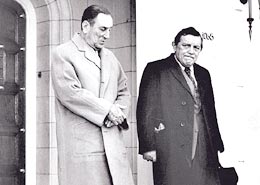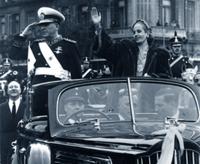خوان پـِرون
| خوان دومينگو پـِرون Juan Domingo Perón | |
|---|---|
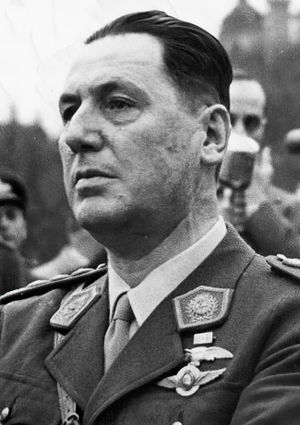
| |
| President of Argentina | |
| في المنصب 12 أكتوبر 1973 – 1 يوليو 1974 | |
| نائب الرئيس | Isabel Martínez de Perón |
| سبقه | Raúl Lastiri |
| خلفه | Isabel Martínez de Perón |
| في المنصب 4 June 1946 – 21 سبتمبر 1955 | |
| نائب الرئيس | Hortensio Quijano Alberto Teisaire |
| سبقه | Edelmiro Farrell |
| خلفه | إدواردو لوناردي |
| نائب رئيس الأرجنتين De facto | |
| في المنصب 8 يوليو 1944 – 10 أكتوبر 1945 | |
| الرئيس | Edelmiro Farrell |
| سبقه | Edelmiro Farrell |
| خلفه | خوان پيستاريني |
| رئيس الحزب العدلي | |
| في المنصب 21 نوفمبر 1946 – 1 يوليو 1974 | |
| سبقه | منصب مستحدث |
| خلفه | Isabel Martínez de Perón |
| Minister of War | |
| في المنصب 24 February 1944 – 10 October 1945 | |
| الرئيس | Pedro Pablo Ramírez Edelmiro Farrell |
| سبقه | Pedro Pablo Ramírez |
| خلفه | Eduardo Ávalos |
| Secretary of Labour and Social Security | |
| في المنصب 1 December 1943 – 10 October 1945 | |
| الرئيس | Pedro Pablo Ramírez Edelmiro Farrell |
| سبقه | Position established |
| خلفه | Domingo Mercante |
| تفاصيل شخصية | |
| وُلِد | Juan Domingo Perón 8 أكتوبر 1895 Lobos, Buenos Aires, Argentina |
| توفي | 1 يوليو 1974 (aged 78) Olivos, Buenos Aires، الأرجنتين |
| المدفن | Museo Quinta 17 de Octubre San Vicente, Buenos Aires، الأرجنتين |
| الحزب | Labour Party (1945–1947) الحزب العدلي (1947–1974) |
| الزوج | Aurelia Tizón (ز. 1929; و. 1938) Eva Duarte (ز. 1945; و. 1952) Isabel Martínez Cartas (ز. 1961) |
| التوقيع | 
|
| الخدمة العسكرية | |
| الولاء | Argentina |
| الخدمة/الفرع | Argentine Army |
| سنوات الخدمة | 1913–1945 |
| الرتبة | Lieutenant General |
| جء من سلسلة عن |
| الشعبوية |
|---|
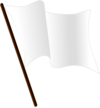 |
خوان دومينگو پـِرون Juan Domingo Perón، (النطق الإسپاني: [ˈxwan doˈmiŋɡo peˈɾon]؛ 8 أكتوبر، 1895 - 1 يوليو 1974)، هو جنرال وسياسي أرجنتيني، انتخب ثلاث مرات لمنصب رئيس الأرجنتين، على الرغم من تمكنه من الخدمة لولاية واحد كاملة فقط، بعد عمله في مناصب حكومية مختلفة، منها وزير العدل ونائب الرئيس. نـُحـِّيَ عن الرئاسة عقب انقلاب عسكري عام 1955. وعاد إلى السلطة عام 1973 لفترة 9 أشهر، حتى وفاته في عام 1974 حيث خلفته زوجتها الثالثة ماريا إستلا مارتينز.
پـِرون وزوجته الثانية، إيڤا دوارتى، يتمتعان بشعبية هائلة بين الأرجنتينيين، وحتى اليوم مازالا يُعتبران أيقونتين بين الپيرونيين. امتدح أتباع الزوجين پـِرون جهودهما للقضاء على الفقر وتكريم العمل، بينما اعتبرهم منتقدوهم غوغائيين وديكتاتورين. أعطى پـِرون اسمه للحركة السياسية المعروفة باسم پيرونيزمو peronismo، التي هي في الأرجنتين الحالية يمثلها في الأساس الحزب العدلي.
تولى المقدم خوان پـِرون مهام رئاسة الجمهورية في الأرجنتين. وقبل ذلك بثلاث سنوات فقط كان بيرون مجرد موظف بسيط في وزارة العمل والشؤون الإجتماعية. وكان لزوجة رئيس الجمهورية إيڤا بيرون تأثير كبير عليه. وهي راقصة سابقة غدت فيما بعد بطلة العديد من الروايات والأفلام والمسرحيات الاستعراضية. وقد سقط نظام حكم بيرون بسبب الفساد الإداري، إلا أنه سرعان ما فاز في الإنتخابات الرئاسية مجدداً، وتزوج امرأة اخرى ، راقصة أيضا في السابق. وقد ورثت إيزابيل منصب زوجها فغدت اول رئيسة جمهورية في العالم.
. . . . . . . . . . . . . . . . . . . . . . . . . . . . . . . . . . . . . . . . . . . . . . . . . . . . . . . . . . . . . . . . . . . . . . . . . . . . . . . . . . . . . . . . . . . . . . . . . . . . . . . . . . . . . . . . . . . . . . . . . . . . . . . . . . . . . . . . . . . . . . . . . . . . . . . . . . . . . . . . . . . . . . . .
الحكومة العسكرية 1943–1946

السياسة الداخلية وفترة الرئاسة الأولى (1946–1952)
Perón and his running mate, Hortensio Quijano, leveraged popular support to victory over a Radical Civic Union-led opposition alliance by about 11% in the February 24, 1946 presidential elections.

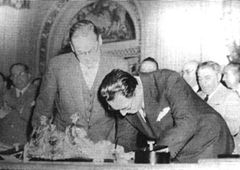
وقد رفض دخول General Agreement on Tariffs and Trade (سلف منظمة التجارة العالمية) أو صندوق النقد الدولي.[1]
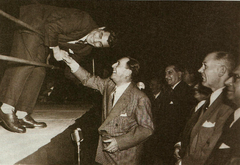
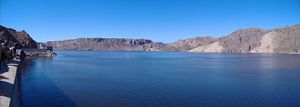
Perón also prioritized the modernization of the Argentine Armed Forces, particularly its Air Force. Between 1947 and 1950, Argentina manufactured two advanced jet aircraft called Pulqui I (designed by the Argentine engineers Cardehilac, Morchio and Ricciardi with the French engineer Émile Dewoitine, condemned in France in absentia for collaborationism), and Pulqui II designed by German engineer Kurt Tank. In the test flights, the planes were flown by Lieutenant Edmundo Osvaldo Weiss and Tank himself, reaching 1000 km/h with the Pulqui II. Argentina continued testing the Pulqui II until 1959; in the tests, two pilots lost their lives.[2] The Pulqui project opened the door to two successful Argentinian planes: the IA 58 Pucará and the IA 63 Pampa manufactured at the Aircraft Factory of Córdoba.[3]
In 1951, Perón announced that the Huemul Project would produce nuclear fusion before any other country. The project was led by an Austrian, Ronald Richter, who had been recommended by Kurt Tank. Tank expected to power his aircraft with Richter's invention. Perón announced that energy produced by the fusion process would be delivered in milk-bottle sized containers. Richter announced success in 1951, but no proof was given. The next year, Perón appointed a scientific team to investigate Richter's activities. Reports by José Antonio Balseiro and Mario Báncora revealed that the project was a fraud. After that, the Huemul Project was transferred to the Centro Atómico Bariloche (CAB) of the new National Atomic Energy Commission (CNEA) and to the physics institute of the Universidad Nacional de Cuyo, later named Instituto Balseiro (IB).[4]
تدخلات وإسهامات إيڤا پـِرون
پـِرون والتجمعات اليهودية والألمانية في الأرجنتين
| ” | When I realized that Perón, contrary to previous governments, gave Jewish citizens access to public office, I began to change my way of thinking about Argentine politics...
Ezequiel Zabotinsky, president of the Jewish-Peronist Organizacion Israelita Argentina, 1952–1955 [5] |
“ |
Fraser and Navarro write that Juan Perón was a complicated man who over the years stood for many different, often contradictory, things.[6] In the book Inside Argentina from Perón to Menem author Laurence Levine, former president of the US-Argentine Chamber of Commerce, writes, "although anti-Semitism existed in Argentina, Perón's own views and his political associations were not anti-Semitic...." Laurence also writes that one of Perón's advisors was a Jewish man from Poland named José Ber Gelbard.[7] U.S. Ambassador George S. Messersmith visited Argentina in 1947 during the first term of Juan Perón. Messersmith noted, "There is not as much social discrimination against Jews here as there is right in نيويورك or in most places at home..."[8]
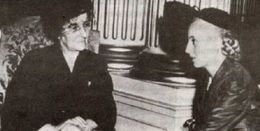
Perón sought out other Jewish Argentines as government advisers, besides Ber Gelbard. The powerful Secretary of Media, Raúl Apold, also Jewish, was (ironically) called "Perón´s Goebbels." He favoured the creation of institutions like New Zion (Nueva Sión), the Argentine-Jewish Institute of Culture and Information, presided by Simón Mirelman, and the Argentine-Israeli Chamber of Commerce. Also, he named Rabbi Amran Blum the first Jewish professor of philosophy in the National University of Buenos Aires. After being the first Latin American government to acknowledge the State of Israel, he sent a Jewish ambassador, Pablo Mangel to that country. Education and Diplomacy were the two strongholds of Catholic nationalism, and both appointments were highly symbolic. The same goes for the 1946 decision of allowing Jewish army privates to celebrate their holidays, which was aimed at fostering the Jewish position in another traditionally Catholic institution, the army. Argentina signed a generous commercial agreement with Israel that granted favourable terms for Israeli acquisitions of Argentine commodities, and also the Eva Perón Foundation sent significant humanitarian aid. Chaim Weizmann and Golda Meir expressed their gratitude during their visit to بوينس آيرس in 1951.
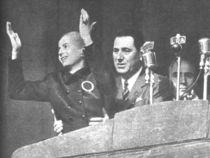
The German Argentine community in Argentina is the third largest ethnic group in the country, after the Spanish Argentines and the Italian Argentines. The German Argentine community predates Juan Perón's presidency, going back as far as the time of the unification of Germany. Laurence Levine writes that Perón found German civilization too "rigid" and therefore had a "distaste" for it.[7] Crassweller writes that while Juan Perón's own personal preference was for Hispanic culture, with which he felt a spiritual affinity, Perón was "pragmatic" in dealing with the diverse populace of Argentina.[8]
While Juan Perón's Argentina allowed many Nazi criminals to take refuge in Argentina, Juan Perón's Argentina also accepted more Jewish immigrants than any other country in Latin America, which in part accounts for the fact that Argentina to this day has a population of over 200,000 Jewish citizens, the largest in Latin America, the third largest in the Americas, and the sixth largest in the world.[9][10][11][12] The Jewish Virtual Library writes that while Juan Perón had sympathized with the Axis powers, "Perón also expressed sympathy for Jewish rights and established diplomatic relations with Israel in 1949. Since then, more than 45,000 Jews have immigrated to Israel from Argentina." [13]
Tomás Eloy Martínez, professor of Latin American studies at Rutgers University, writes that Juan Perón allowed Nazi criminals into the country in hopes of acquiring advanced German technology developed during the war. Martínez also notes that Eva Perón played no part in allowing Nazis into the country.[14]
. . . . . . . . . . . . . . . . . . . . . . . . . . . . . . . . . . . . . . . . . . . . . . . . . . . . . . . . . . . . . . . . . . . . . . . . . . . . . . . . . . . . . . . . . . . . . . . . . . . . . . . . . . . . . . . . . . . . . . . . . . . . . . . . . . . . . . . . . . . . . . . . . . . . . . . . . . . . . . . . . . . . . . . .
الفترة الرئاسية الثانية لپـِرون
ضريحه وعهده
- Also see Hands of Perón.
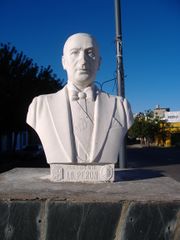
الهوامش
- ^ خطأ استشهاد: وسم
<ref>غير صحيح؛ لا نص تم توفيره للمراجع المسماةrock - ^ "El proyecto Pulqui: propaganda peronista de la época". Lucheyvuelve.com.ar. Retrieved 2011-01-27.
- ^ "La aviación militar apunta a Córdoba como vector comercial del poder aéreo". Reconstruccion2005.com.ar. Retrieved 2011-01-27.
- ^ خطأ استشهاد: وسم
<ref>غير صحيح؛ لا نص تم توفيره للمراجع المسماةcrawley - ^ "The Jews and Perón: Communal Politics and National Identity in Peronist Argentina, 1946–1955" by Lawrence D. Bell Page 10. Retrieved May 2, 2008
- ^ Fraser, Nicholas. Navarro, Marysa. Evita: The Real Life of Eva Perón. W.W. Norton & Company, New York, London. 1980, 1996.
- ^ أ ب Inside Argentina from Perón to Menem: 1950–2000 From an American Point of View by Laurence Levine, page 23 ISBN 0-9649247-7-3
- ^ أ ب خطأ استشهاد: وسم
<ref>غير صحيح؛ لا نص تم توفيره للمراجع المسماةautogenerated2 - ^ "Continuing Efforts to Conceal Anti-Semitic Past." Valente, Marcela. Valente, Marcela. IPS-Inter Press Service. April 27, 2005.
- ^ The Jewish People Policy Planning Institute; Annual Assessment, 2007[dead link]
- ^ "United Jewish Communities; Global Jewish Populations". Ujc.org. 2009-03-30. Retrieved 2011-01-27.
- ^ [1][dead link]
- ^ Jewish Virtual Library. http://www.jewishvirtuallibrary.org/jsource/vjw/Argentina.html#WW2
- ^ THE WOMAN BEHIND THE FANTASY: PROSTITUTE, FASCIST, PROFLIGATE - EVA PERÓN WAS MUCH MALIGNED, MOSTLY UNFAIRLY Tomás Eloy Martínez, Director of the Latin American program at Rutgers University
قراءات إضافية
- David Cox and Damian Nabot, Unveiling the enigma: Who Stole the Hands of Juan Perón? (Zumaya 2009)
- Gabriele Casula (2004) "Dove naciò Perón? un enigma sardo nella storia dell'Argentina" http://www.editorisardi.it/catalogo/shopping/book_enlarge.php?id=2470 - http://www.condaghes.com/scheda.asp?id=88-7356-028-8
- Guareschi, Roberto (Nov. 5, 2005). "Not quite the Evita of Argentine legend". New Straits Times, p. 21.
- Hugo Gambini (1999). Historia del peronismo, Editorial Planeta. F2849 .G325 1999
- Nudelman, Santiago (Buenos Aires, 1960; Chiefly draft resolutions and declarations presented by Nudelman as a member of the Cámara de Diputados of the Argentine Republic during the Perón administration)
- Page, Joseph. Perón: a biography (Random House 1983)
انظر أيضا
وصلات خارجية
- Casahistoria pages on Perón Les Fearns site, also links to Eva Perón pages
- The Twenty Truths of the Peronist Movement (1940s) The Justicialist movement's core tenets.
- Juan Domingo Perón Argentine Presidential Messages Well indexed dating from 1946 onwards. The actual documents are shown as photocopied images. Note: Downloading can be slow! University of Texas.
- Perón y el peronismo: un ensayo bibliográfico by Mariano Ben Plotkin.
- Webpage of author Uki Goñi with extensive documentation on Perón's involvement in harboring Nazi fugitives
| مناصب سياسية | ||
|---|---|---|
| سبقه Edelmiro Farrell |
نائب رئيس الأرجنتين 1944–1945 |
تبعه Juan Pistarini |
| رئيس الأرجنتين فترة أولى وثانية 1946–1955 |
تبعه José Gómez | |
| سبقه Raúl Lastiri |
رئيس الأرجنتين الفترة الثالثة 1973–1974 |
تبعه Isabel Perón |
- Articles with dead external links from January 2011
- Missing redirects
- Articles with hatnote templates targeting a nonexistent page
- مواليد 1895
- وفيات 1974
- ضباط جيش أرجنتينيون
- Argentine people of indigenous peoples descent
- أرجنتينيون من أصل ايطالي
- أرجنتينيون من أصل اسكتلندي
- أرجنتينيون من أصل إسباني
- وفيات باحتشاء عضل القلب
- Justicialist Party politicians
- فرسان مالطا
- زعماء أطاحت بهم انقلابات
- حائزو مرتبة الاستحقاق لجمهورية ألمانيا الاتحادية
- أشخاص حرمتهم الكنيسة الكاثوليكية
- People from Buenos Aires Province
- رؤساء الأرجنتين
- نواب رؤساء الأرجنتين

